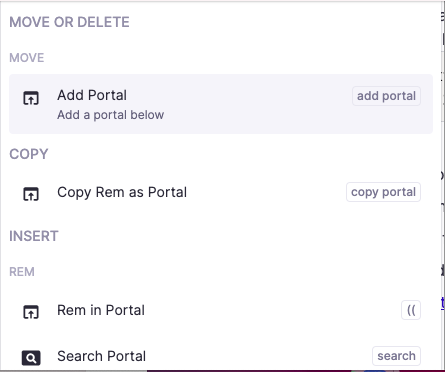Portals, tags, daily documents and workflow
TL/DR: What is the best workflow for aggregating topical data that is added to RN over the course of multiple days? Daily documents + some use of portals and tags OR dedicated folders? (Also, no video on portals has yet helped me really understand how to work with them.)
It is my understanding that RemNote can be used with a traditional folder system. That is to say, when I want to take notes on a book I’m reading, I can open a folder that I’ve created called “Books” and then find the book, open its document and begin taking notes or add to those notes on subsequent days. However, my further understanding is that RemNote is really useful for a different type of workflow that is more efficient and doesn’t depend on finding the right folder and document for adding to your notes. I’ve seen videos recommending that I do everything in my daily documents, and use portals (or Rem references? Or tags?? I have no clue which is best to use when) instead to collect information on one subject in one place. I have attempted to do this but I end up with documents that appear cluttered and chaotic to me. Let me give an example…
It’s Monday and I open a Daily Doc. The first activity I do that day is to start taking notes on a new book I am reading called “The Ghost Map” by Steven Johnson. I’m tempted to create a separate document called “The Ghost Map” and always open it every time I want to take notes, but I decide to try a different way:
Monday, in my Daily Doc…
- I type The Ghost Map and use [[ to make it a Rem Reference. I’m confused as to whether this is essentially a tag as well.
- I take notes as usual, making flashcards where it seems appropriate. I get through Ch 1.
- While taking notes on Ch. 1, the Crimean War is mentioned. I realize that I don’t remember anything about the Crimean War, so I decide that I will make it a Rem Reference as well. My plan is that I will later look up some basic information on the Crimean War and add it to RemNote.
Tuesday (new Daily Doc)
- I want to take notes on Ch. 2 of The Ghost Map. This is where I get confused.
-
Do I import “The Ghost Map” (which is, in my mind, simply a Rem Reference at this point) into this Tuesday document? Now I have a portal in my Tues. Daily Doc? If I do, is it like pulling in all of my Ch. 1 notes into Tuesday so I can see them and continue taking notes? That seems cumbersome if the notes are long.
-
Or do I just start taking notes on Ch. 2 in my Tuesday daily doc and tag it by ##The Ghost Map? Or use [[ ? How are these different?
-
Or do I leave the daily doc and go to the Rem Reference/document for the book and take notes there? (THIS is when I usually don’t like what I see when I go to a Rem reference that I’ve taken notes on over several days in different DDs. ) Specifically in this case, rather than seeing a clean document with my notes from Ch. 1 waiting for me to continue with notes for the next chapter, I have a document with “The Ghost Map” at the top and then a reference at the bottom of the document — specifically a reference to Monday’s DD where I first started taking notes.
-
Are my expectations wrong? If I want a nice document for this book with all of my notes, should I avoid taking the notes in my DD completely and simply open the book’s “folder” and take notes there?
Wednesday (new Daily Doc)
-
I want to read over my notes for Ch. 1 and 2 from The Ghost Map. At this point, I have no idea what to do. Am I supposed to search for a tag? A rem ref? Is a portal search (?) the right option?
-
What if I want to find something specific in my notes from this book?
-
I read something interesting about the Crimean War, which I made a Rem reference in the first chapter of The Ghost Writer but which is still a stub. I want to jot this information down, but where do I do this and how? How do portals and tags relate to each other and to this need to record this bit of information?
I constantly hear how powerful the portals are, so I really want to understand how they fit into the process of learning and taking notes and how they are related to creating tags. But right now, I am not understanding how to take notes across daily documents without ending up with a messy list of references for a Rem reference.



